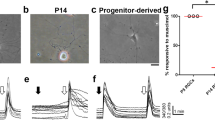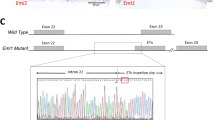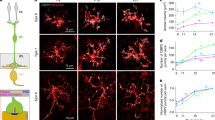Abstract
VISUALIZATION of layering phenomena in several light microscopic studies1–5 has given rise to the view that the retina matures morphologically in a centrifugal sequence from inner to outer layers, with ganglion cells maturing first and receptors last6. On the other hand, in a variety of species (mouse7, rat8, rabbit2, dog9, chick10 and frog11) in which the order of appearance of light-evoked electroretinographic wave forms has been followed through the developmental period, the a-wave, which is believed to arise at an outer retinal level12,13, could be elicited several days earlier than the b-wave which is believed to arise at an inner retinal level14–16. A centripetal sequence of at least certain aspects of functional maturation, from outer to inner levels of the retina, is suggested by these data.
This is a preview of subscription content, access via your institution
Access options
Subscribe to this journal
Receive 51 print issues and online access
$199.00 per year
only $3.90 per issue
Buy this article
- Purchase on Springer Link
- Instant access to full article PDF
Prices may be subject to local taxes which are calculated during checkout
Similar content being viewed by others
References
Cajal, S. R., Studies on Vertebrate Neurogenesis (translated by Guth, L.), 353 (C. C. Thomas, Springfield, Illinois, 1960).
Noell, W. K., Arch. Ophthalmol., 60, 702 (1958).
Sorsby, A., Keller, P. C., Attfield, M., Davey, J. B., and Lucas, D. R., J. Exp. Zool., 125, 171 (1954).
Glucksmann, A., Brit. J. Ophthalmol., 24, 153 (1940).
Sidman, R. L., The Structure of the Eye (edit. by Smelser, G. K.), 487 (Academic Press, New York, 1961).
Walls, G. L., The Vertebrate Eye and its Adaptive Radiation, 108 (Hafner, New York, 1963).
Keeler, C. E., Sutcliffe, E., and Chaffee, E. L., Proc. US Nat. Acad. Sci., 14, 811 (1928).
Dowling, J. E., and Sidman, R. L., J. Cell Biol., 14, 73 (1962).
Horsten, G. P. M., and Winkelman, J. E., Arch. Ophthalmol., 63, 232 (1960).
Witkovsky, P., Vision Res., 3, 341 (1963).
Crescitelli, F., and Nilsson, S. E. C., Science, 151, 1545 (1966).
Brown, K. T., and Wiesel, T. N., J. Physiol., 158, 267 (1961).
Brown, K. T., Watanabe, K., and Murakami, M., Cold Spring Harbor Symp. Quant. Biol., 30, 457 (1965).
Noell, W. K., Amer. J. Ophthalmol., 38, 78 (1954).
Tomita, T., and Torihama, Y., Jap. J. Physiol., 6, 118 (1956).
Yamashita, E. Tohoku, J. Exp. Med., 70, 221 (1959).
Dowling, J. E., and Boycott, B. B., Proc. Roy. Soc., B, 166, 80 (1966).
Cohen, A. I., Amer. J. Anat., 120, 319 (1967).
Raviola, G., and Raviola, E., Amer. J. Anat., 120, 403 (1967).
Dowling, J. E., Science, 155, 273 (1967).
Author information
Authors and Affiliations
Rights and permissions
About this article
Cite this article
OLNEY, J. Centripetal Sequence of Appearance of Receptor–Bipolar Synaptic Structures in Developing Mouse Retina. Nature 218, 281–282 (1968). https://doi.org/10.1038/218281a0
Received:
Revised:
Issue Date:
DOI: https://doi.org/10.1038/218281a0
This article is cited by
-
The expression pattern and assembly profile of synaptic membrane proteins in ribbon synapses of the developing mouse retina
Cell and Tissue Research (2003)
-
An ultrastructural analysis of the development of foetal rat retina transplanted to the occipital cortex, a site lacking appropriate target neurons for optic fibres
Journal of Neurocytology (1982)
-
Histotypic organization of the rat retina in vitro
Zeitschrift f�r Zellforschung und Mikroskopische Anatomie (1971)
Comments
By submitting a comment you agree to abide by our Terms and Community Guidelines. If you find something abusive or that does not comply with our terms or guidelines please flag it as inappropriate.



